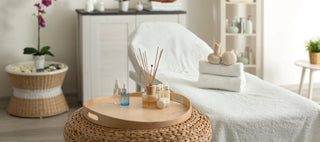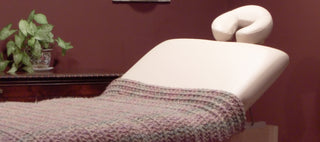Massage therapists often ask, “Why do massage tables get sticky?” The answer lies in a combination of factors, from oil build-up to environmental conditions. Stickiness affects the table’s appearance and its usability and hygiene. A sticky massage table can create discomfort for clients and additional work for therapists. Understanding the causes of stickiness and how to address them can help maintain your table’s quality and extend its lifespan.

Understanding the Sticky Situation
Massage tables can become sticky for a variety of reasons, but understanding the primary causes can help you address the problem effectively. Stickiness often stems from a mix of oil residue and environmental factors, making it a recurring issue for massage therapists. Identifying and managing these factors is key to keeping your table in good shape and ensuring a pleasant experience for your clients.
Additionally, stickiness isn’t just an aesthetic issue—it can impact the table’s usability and even lead to long-term damage if not managed. By recognising the contributing factors early, you can take steps to clean, maintain, and protect your equipment, saving time and reducing the risk of replacement costs.

The Culprit: Oil Buildup
Massage oils are a key part of creating a smooth and relaxing experience, but they often leave behind an unwanted problem: stickiness. Over time, these oils seep into the table’s surface, leaving a tacky residue that isn’t easy to clean. This happens because oils, especially heavier synthetic ones, interact with the materials used in massage tables, such as vinyl or synthetic leather. Natural oils like coconut or almond oil might absorb differently, but they can still contribute to the issue if not cleaned properly.
Excess oil use, combined with infrequent cleaning, allows this residue to accumulate. Even high-quality oils can create build-up if tables aren’t maintained regularly. Knowing which oils are less likely to cause problems and adopting consistent cleaning practises can help reduce this sticky situation.
The Role of Heat and Humidity
Heat and humidity can accelerate the breakdown of your table’s surface, making stickiness worse. During massages, body heat makes oils sink deeper into the material. When combined with high room temperatures or humid environments, this can degrade the protective coating of the table and increase residue build-up.
Room conditions also play a role. High humidity encourages moisture retention on the surface, trapping oils and making them harder to remove. Similarly, storing your table in a space exposed to sunlight or temperature fluctuations can lead to faster wear and tear. Keeping your massage room at a consistent, moderate temperature and humidity level helps protect your table.
Cleaning Your Sticky Massage Table
A sticky massage table doesn’t just look unpleasant; it can impact your client’s experience and your workflow. Tackling stickiness involves a combination of using the right supplies, adopting proper cleaning techniques, and maintaining a regular cleaning schedule. While stickiness often feels like a hassle, it’s manageable with a few straightforward steps that keep your table hygienic and comfortable for clients.
Understanding how oils, sweat, and environmental factors contribute to stickiness helps in choosing the right cleaning methods. This section will guide you through essential tools, effective cleaning practises, and tips to prevent future issues. With consistent care, you can prolong your table’s lifespan and maintain a professional setup.

Essential Cleaning Supplies
To properly clean a sticky massage table, having the right supplies is important. You’ll need mild soap or a pH-neutral cleaner, warm water, rubbing alcohol (used sparingly), and soft, non-abrasive cloths such as microfibre towels. Gloves can also be helpful to protect your hands during cleaning. These basic items are effective and widely available, making them a practical choice for regular maintenance.
Using specialised cleaning products made for massage tables can also help, as they’re designed to tackle oil residue without damaging the surface. Avoid harsh chemicals or abrasive materials, as these can strip protective coatings or cause scratches.
Step-by-Step Cleaning Process
- Wipe Down the Surface: Begin by using a damp microfibre cloth to remove loose dirt and any surface residue.
- Apply Cleaning Solution: Mix a small amount of mild soap with warm water, or use a pH-neutral cleaner. Gently scrub the surface in circular motions to lift the sticky residue.
- Handle Stubborn Residue: For areas that remain tacky, apply a small amount of rubbing alcohol using a soft cloth. Test in an inconspicuous spot first to avoid damage.
- Rinse Thoroughly: Use a clean, damp cloth to remove all cleaning product residues, ensuring the table is free of soap or chemicals.
- Dry Completely: Wipe the table dry with a soft towel to prevent moisture from seeping into the surface.
Regular cleaning after every session, along with weekly deeper cleans, can keep your table in better condition for longer.
Preventing Future Stickiness
Protecting your massage table from stickiness doesn’t have to be complicated. Start by using a waterproof or disposable table cover to shield the surface from oils. These covers act as a barrier, preventing oils from seeping into the material. Washing reusable covers frequently helps, too. Keep your massage table and accessories in top shape! See Natural Living’s premium range of protective covers here.
Cutting back on the amount of oil used during massages can also make a big difference. Applying oils in smaller quantities and adding more if needed reduces residue build-up. Storing your table in a cool, dry place, away from sunlight, helps prevent surface degradation over time. Cleaning the table even when it doesn’t feel sticky can prevent small residues from building up unnoticed.

When to Replace Your Massage Table
Replacing a massage table isn’t a decision therapists make lightly, but recognising when it’s time can save you from ongoing frustrations. Persistent stickiness, visible damage, or uncomfortable surfaces are all indicators that your table may no longer serve your needs effectively. Tables endure regular use, exposure to oils, and environmental wear, which over time, compromises their quality and usability.
Investing in a new table can also improve your professional image and improve client satisfaction. Modern tables often come with improved materials that are more resistant to oil and easier to clean. While it may seem like an upfront cost, replacing an old table can save time and maintenance expenses in the long term, ensuring your practise remains efficient and inviting.
Signs of Wear and Tear
Massage tables, like any other equipment, won’t last forever. Signs that your table might need replacing include visible cracks, discolouration, or a persistently tacky surface. These issues not only make the table harder to clean but can also affect client comfort and hygiene.
Small cracks or peeling surfaces can trap oil and dirt, making cleaning even harder. Persistent stickiness, even after thorough cleaning, often signals that the table’s materials have started to degrade. Regularly inspecting your table for these signs can help you decide when it’s time to upgrade.
Investing in a New Table
When replacing your massage table, consider factors like durability, material quality, and ease of maintenance. Tables made from high-grade vinyl or synthetic leather are more resistant to oil penetration and easier to clean. Features like adjustable height, portability, and weight capacity are worth considering, especially if you work in different locations or see a variety of clients.
Choosing a table with a robust build and a protective surface coating can save you time and money in the long run by reducing maintenance needs and lasting longer.

Conclusion
So, why do massage tables get sticky? It’s mostly due to oil build-up, combined with factors like heat, humidity, and infrequent cleaning. Tackling this issue requires a combination of consistent maintenance, using the right cleaning products, and preventing future residue through protective measures.
By addressing stickiness proactively and knowing when to replace your massage table, you can keep your massage practise professional and welcoming for clients. A well-maintained table is practical and also a reflection of the care you bring to your work.
Related Blogs:
- How to Maintain Your Electric Massage Table
- How Long Do Portable Massage Tables Last?
- Enhance Your Spa Experience with Quality Massage Table Covers
- A Guide to Massage Table Cover and Accessories to Improve Comfort
- Massage Table Sheet Sizing Guide: What Size Sheets Do I Need?











